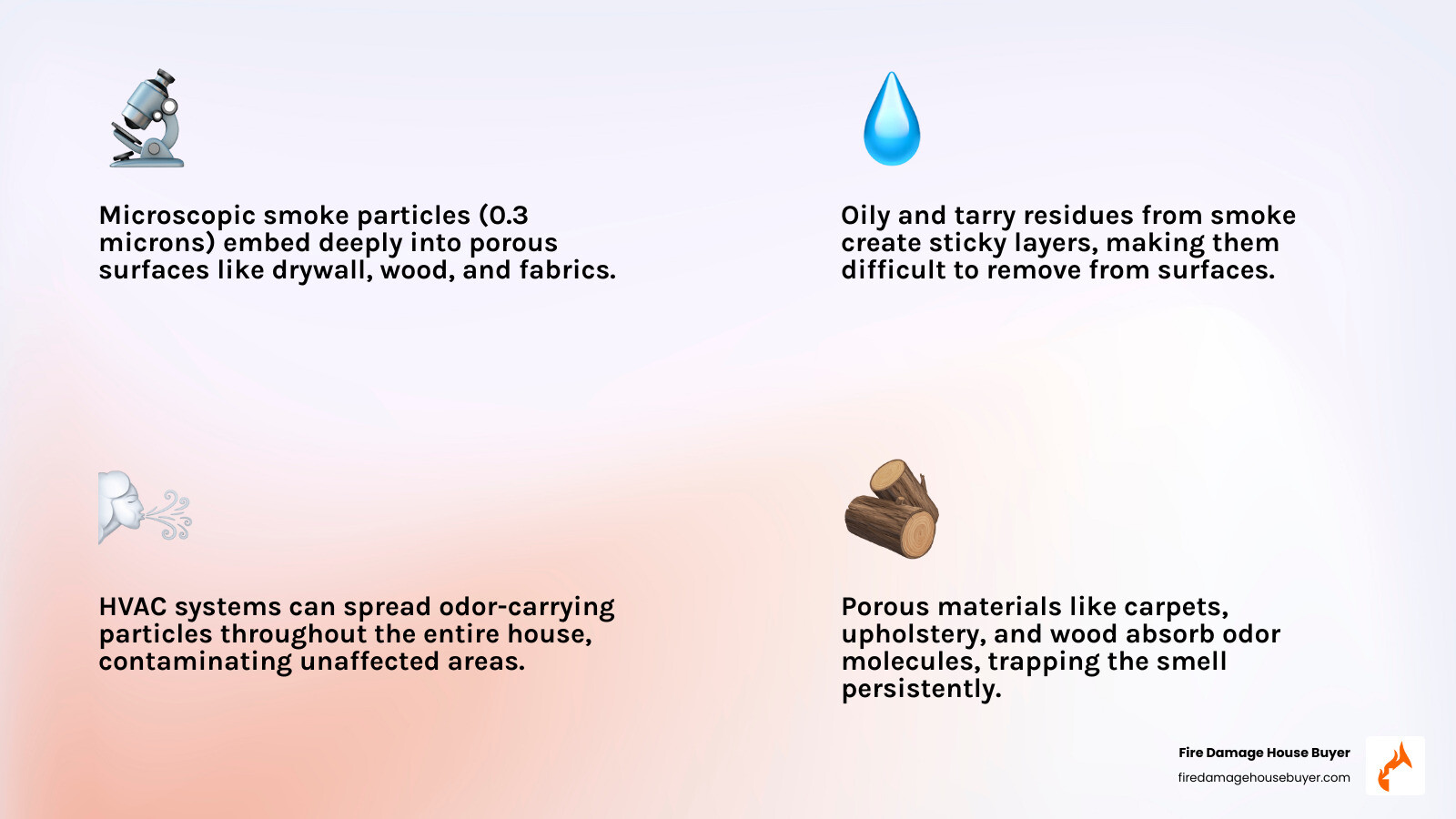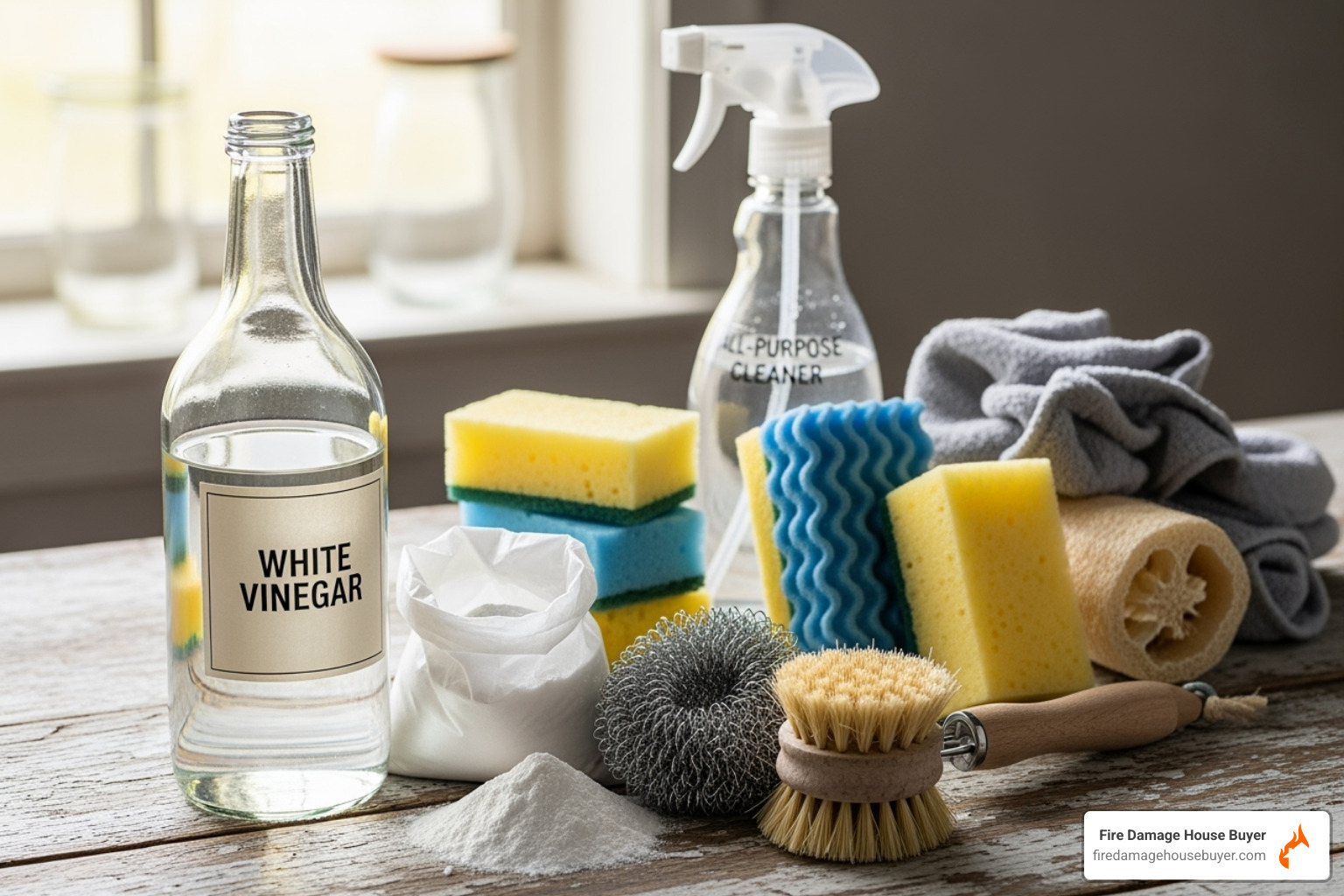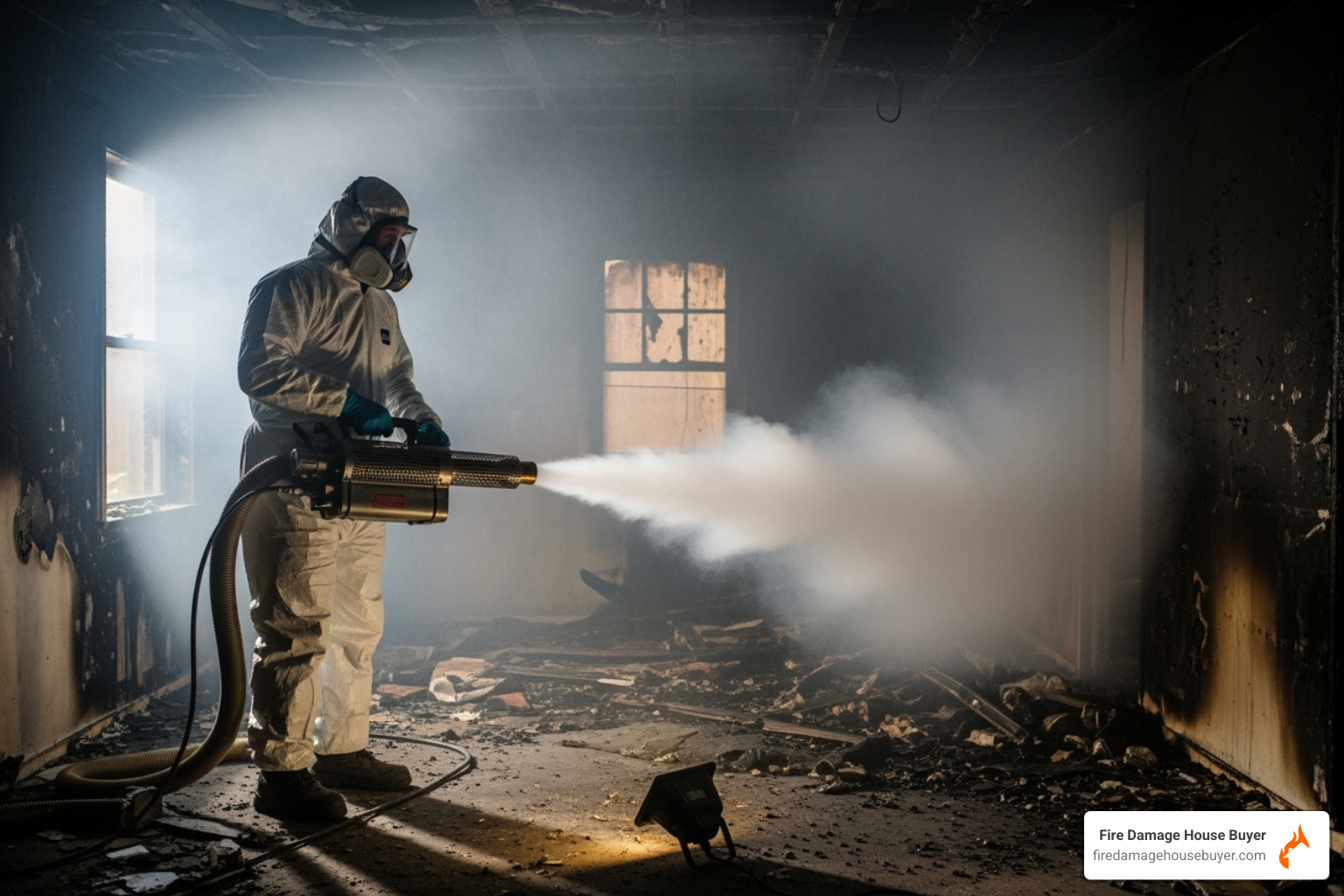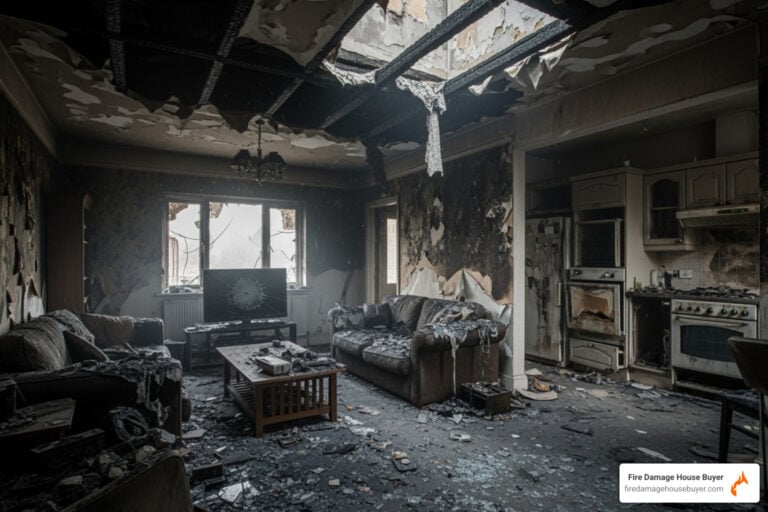The Lingering Problem: Understanding Fire Smoke Odor
How to get rid of fire smoke smell in house is a pressing concern after a fire. This persistent odor is a complex challenge requiring immediate action and often professional help.
Quick Answer: Essential Steps to Remove Fire Smoke Smell
- Ventilate immediately – Open all windows and use fans to push smoky air out
- Clean all surfaces – Use TSP solution (4-6 tbsp + 1 cup cleaner per gallon of water) for walls, floors, and furniture
- Wash fabrics repeatedly – Add 1 cup vinegar to wash cycles, air dry only
- Replace HVAC filters – Change monthly for the first year after fire
- Use odor absorbers – Place bowls of baking soda, activated charcoal, or white vinegar throughout the house
- Consider professional help – For persistent odors or extensive damage
The challenge with fire smoke odor goes beyond the surface. Smoke particles are microscopic and persistent. They penetrate deep into porous materials like drywall, wood, carpets, and fabrics, creating a smell that can linger for months or even years if not properly addressed.
Why smoke odor is so stubborn:
- Tiny particles (as small as 0.3 microns) embed into surfaces, clinging “tenaciously to furniture and clothing” and working their way “into carpeting, floors, walls and ceilings.”
- Oil and tar from burned materials create sticky residues that are difficult to remove.
- HVAC systems can circulate contaminated air throughout the house, spreading the odor to unaffected areas.
- Porous materials absorb and hold odor molecules, making them incredibly difficult to release.
The health risks are also real. Lingering smoke particles contain harmful substances like carbon monoxide and VOCs, which can cause headaches, nausea, and respiratory issues, especially for those with pre-existing conditions. The overwhelming smell itself can pose a health risk.
For many homeowners, the restoration process becomes overwhelming. Professional smoke remediation can cost thousands of dollars, and DIY methods require weeks of intensive labor with no guarantee of success. Some materials—like mattresses, pillows, and heavily damaged drywall—often need complete replacement.
I’m Daniel Cabrera. I’ve helped over 275 homeowners with fire-damaged properties, including tackling the smoke smell problem. My experience shows that restoration costs often exceed expectations, making a cash sale a smarter financial choice for many.

First Response: Immediate Steps to Take After a Fire
After a fire, once safety is confirmed, the priority is minimizing damage. Addressing the smoke smell quickly is crucial, as particles settle fast and become harder to remove over time.
Safety First: Protecting Ourselves During Cleanup
Before cleaning, safety is paramount. The air in a fire-damaged home can be hazardous, filled with soot and microscopic smoke particles. Protect yourself from inhaling these harmful substances and from contact with caustic cleaning agents.
- Protective Gear: Always wear rubber gloves, safety glasses, and a respirator mask (N-95 or higher) during cleanup. This prevents skin irritation, eye damage, and inhalation of fine particles.
- Assessing Structural Safety: Never enter a fire-damaged building without ensuring it’s structurally sound. Consult with fire department officials or a structural engineer if there’s any doubt. Your safety is worth more than any possession.
- Ventilation: As soon as it’s safe, open all windows and doors to create cross-ventilation. Use box fans placed in windows to exhaust smoky air outwards. This helps to air out the home and reduce the concentration of smoke particles. Keep closet doors and other typically closed doors open to allow air circulation.
- Sealing Off Unaffected Rooms: If only a portion of your home was affected, seal off unaffected areas with plastic sheeting and tape to prevent smoke and soot from spreading further.
Initial Soot Removal
Soot is the visible manifestation of smoke particles, and it’s surprisingly tricky to clean. “Smoke particles settle on almost every surface, so cleaning is a key part of the deodorizing process.”
- HEPA-Filter Vacuum: Use a vacuum cleaner equipped with a HEPA filter to gently remove loose soot from all surfaces, including walls, ceilings, and upholstery. Regular vacuums can just spread fine particles around.
- Dry Cleaning Sponges: These specialized sponges are excellent for “erasing” soot from dry surfaces without smearing. Work in small sections, wiping in one direction, and cutting off soiled portions of the sponge as you go.
- Remove Debris: Wet down any debris to minimize breathing dust particles during removal.
For more helpful tips on cleaning up after a fire, we often refer to resources like the American Red Cross. Their guide offers valuable insights into the immediate steps and precautions to take: Helpful cleanup tips from the American Red Cross.
Navigating the aftermath of a fire can also involve complex insurance claims. Understanding your options and rights is essential. We’ve put together a guide to help you through this process: Fire Damage Insurance Claims Guide.
The Deep Clean: How to Get Rid of Fire Smoke Smell in House
Once initial safety measures are done and loose soot is removed, it’s time for the deep clean. This is where we tackle the core problem of how to get rid of fire smoke smell in house. “There’s no quick way to bypass this stage—smoke particles adhere to… everything.”

Cleaning Smoke Odor from Hard Surfaces
Hard surfaces like walls, ceilings, floors, and woodwork can still absorb significant smoke odor.
- Walls and Ceilings: “Use a mixture of water and mild detergent to clean walls and ceilings.” For a more potent solution, “mix together 4 to 6 tbsp. tri-sodium phosphate (TSP) and 1 cup household cleaner or chlorine bleach to every gallon of warm water.” TSP is a powerful cleaning agent that can reduce odors, but it’s caustic, so “wear rubber gloves” and always “read the label for directions and safety instructions.” Test this solution on an inconspicuous area first to ensure it doesn’t discolor surfaces.
- Floors and Woodwork: Similar cleaning solutions can be used here. For painted walls, wood, and other hard surfaces, “wipe down all surfaces… with mild soap or appropriate cleaning solutions and rinse thoroughly.”
- Cleaning from the Floor Up: When cleaning walls, start from the floor and work your way up in small sections. This prevents dirty water from streaking clean areas. “Rinse with clear warm water and dry thoroughly” immediately after cleaning each section. “Ceilings should be washed last.” Do not repaint until surfaces are completely dry.
- White Vinegar and Water Solution: For a more natural approach, a 50/50 mixture of white vinegar and water can be effective, especially for surfaces like plastic or metal blinds. Vinegar’s low pH attacks smoke molecules, helping to neutralize the odor.
How to get rid of fire smoke smell in house from Fabrics and Textiles
Fabrics are notorious for holding smoke odor. Their porous nature allows smoke particles to embed deeply, a key challenge when learning how to get rid of fire smoke smell in house.
- Clothing and Linens: “Wash your clothing and towels using your normal household detergent.” The American Red Cross suggests using cold water and “adding one tablespoon of pure vanilla extract to a load of clothing.” Another effective method is to “add 1 cup of vinegar in the wash cycle, along with the usual detergent.”
- Multiple Wash Cycles: “One washing may not remove all the damage. If you still smell smoke when the clothes come out of the washing machine, immediately wash them again using the same process and continue until the smell is gone.”
- Air-Drying Only: “Do not put smoky clothes in a drying machine because it can lock odors in the material.” Air-dry clothes outdoors if possible, or in a well-ventilated area.
- Washable vs. Dry-Clean-Only Items:
- Washable: Curtains, slipcovers, bedding, and most clothing can be machine washed.
- Dry-Clean-Only: Delicate items, certain drapes, and some upholstered furniture covers should be taken to a professional dry cleaner, making sure to inform them of the smoke damage. For “oily soot on fabrics, avoid using a washing machine and opt for dry cleaning.”
- Carpets and Upholstery: These items often require more intensive treatment.
- Sprinkling Baking Soda: “Place bowls of baking soda around the house. Sprinkle it on carpets, let it sit, and then vacuum it up.” For upholstery, sprinkle baking soda, let it sit for several hours (or even overnight), then vacuum thoroughly.
- Steam Cleaning: “Clean and deodorize all carpets, window coverings, upholstered furniture and mattresses with steam or other appropriate equipment.” Steam cleaning can melt the hardened tar and oils that encapsulate smoke molecules, making them easier to remove.
- Professional Cleaning: For heavily soiled or delicate items, or if the smell persists, professional cleaning services are highly recommended. “Upholstery, fabric window treatments, etc., can be spray-treated with deodorizing products available at most supermarkets, but do not use odor-masking sprays.”
Tackling Your HVAC System and Hidden Odors
The HVAC system can spread smoke odor by drawing particles into its ductwork and circulating them throughout your home. Cleaning it is key to solving how to get rid of fire smoke smell in house.
- HVAC System’s Role: “Smoke particles can infiltrate HVAC systems,” making it a crucial area for cleaning. “Fire smoke can permeate ductwork and linger in the ventilation system.”
- Replacing All Air Filters: “Change filters when you first return to the premises and at least once a month for the first year.” This is a simple yet vital step to prevent recirculation of smoke particles. Consider upgrading to a high-quality filter, such as a HEPA filter, for better air purification. What is a HEPA filter?
- Professional Duct Cleaning: “Have heating, ventilating and air-conditioning units and all ductwork professionally cleaned to remove soot, ash and smoke residue.” This ensures that hidden smoke particles aren’t continuously reintroduced into your living space.
- Cleaning Inside Cabinets and Closets: Smoke can penetrate even closed spaces. Empty all drawers and closets, wipe down all interior surfaces with a mild detergent or vinegar solution, and leave them open to air out for several days. “Wash, dust or otherwise clean all household items, including knick-knacks.”
- Using Odor Absorbers: Beyond cleaning, we need to actively absorb lingering odors from the air and surfaces.
- Activated Charcoal: “Place bowls of activated charcoal throughout the affected area.” Activated charcoal is highly porous and excellent at trapping odor molecules.
- Bowls of Baking Soda or Vinegar: “Place bowls of baking soda around the house.” Similarly, “place bowls of white vinegar around the house or simmer vinegar on the stovetop (don’t burn it!).” These natural substances absorb or neutralize odors effectively.
- Air Purifiers: “Air purifiers with HEPA filters are highly effective at capturing and trapping smoke particles.” Place these in the most affected areas.
Advanced & Professional Smoke Remediation
If the smoke smell persists despite your best efforts, it likely means smoke has deeply infiltrated porous materials or the fire was severe. When this happens, it’s time to consider advanced techniques and professional help.

When DIY Methods Aren’t Enough
For severe smoke damage, especially after a significant house fire, DIY methods might only scratch the surface. This is where specialized equipment and expertise become invaluable.
- Ozone Generators: “The most effective method of removing smoke smells is to destroy the particles with an ozone generator.” Ozone (O3) is a powerful oxidizing agent that breaks down odor-causing molecules. However, they must be used with extreme caution. “Professional use due to health and property dangers” is highly recommended. The property must be completely vacated by humans and pets during and for several hours after treatment, as ozone can be harmful to respiratory systems.
- Hydroxyl Generators: Similar to ozone generators, hydroxyl generators use a chemical reaction to create hydroxyl radicals, which neutralize odors at a molecular level. They are generally safer for use in occupied spaces (though still often used in unoccupied spaces for maximum effectiveness) and don’t produce ozone.
- Thermal Fogging: This professional technique involves releasing a fine mist of deodorizing solution that penetrates porous materials in the same way smoke did. It effectively neutralizes odors that have soaked into walls, furniture, and other surfaces.
- Odor-Sealing Primers and Paints: If smoke has deeply permeated walls and ceilings, even after cleaning, the odor might return. “Use a stain-blocking primer before repainting. This can seal in any remaining smoke particles and prevent the odor from seeping through the new paint.” This is often a last resort for surfaces that retain stubborn smells.
- The High Cost of Professional Services: Professional smoke remediation is a significant investment. Costs can range from a few thousand dollars for targeted odor removal to tens of thousands for comprehensive restoration, depending on the damage and home size. A full-scale remediation with material replacement could run $10,000 to $50,000 or more, not including fire damage repairs.
When the damage is extensive and the task of restoration feels overwhelming, it’s wise to consider your options. Our guide to fire damage restoration and repair can provide more context on the scope of work involved: Fire Damage Restoration & Repair.
Comparing Your Restoration Options
Deciding between DIY and professional restoration can be a tough call, especially given the emotional toll a fire takes. Let’s look at a comparison:
| Feature | DIY Restoration | Professional Restoration |
|---|---|---|
| Cost | Lower upfront material cost (cleaners, filters, time) | Higher upfront cost (equipment, labor, specialized chemicals) |
| Time | Weeks to months of personal labor | Days to weeks for specialized teams |
| Effectiveness | Good for light to moderate damage, often requires repeat efforts | Highly effective for severe and persistent odors |
| Labor | Intensive personal effort, physically and emotionally draining | Minimal personal effort, highly trained and equipped teams |
The “hidden costs of restoration” extend beyond money to your time, energy, and the emotional toll of living in a compromised environment. We’ve seen homeowners spend months trying to restore their homes, only to find the odor persists or costs become unmanageable. This often leads to the difficult question: Rebuild or Sell After House Fire?
The Simpler Alternative: Selling Your Fire Damaged House
After understanding the effort, time, and cost of restoration, many homeowners realize it might not be the best path. The reality of a long, arduous restoration process can be daunting.

- The Reality of a Long Restoration: We’ve seen families in Alabama, Alaska, Arizona, and across all 50 states grapple with the aftermath of a fire. The restoration process is rarely quick. It involves coordinating with contractors, dealing with unexpected expenses, and living in a construction zone for months. The emotional and physical toll can be immense.
- Unexpected Expenses: Even with insurance, many costs can arise that aren’t fully covered. Professional remediation, material replacement, and temporary housing can quickly deplete savings.
- Dealing with Contractors: Finding reliable contractors, managing schedules, and ensuring quality work adds another layer of stress to an already difficult situation.
The Stress-Free Option: Selling Your House “As-Is”
At Fire Damage House Buyer, we offer a simpler, less stressful alternative. Instead of a seemingly endless restoration, you can choose to sell your fire-damaged house to us exactly “as-is.”
- No Repairs or Cleaning Needed: That’s right. You don’t have to worry about cleaning up soot, removing smoke smell, or fixing any damage. We buy houses in their current condition, no matter how severe the fire or smoke damage.
- Getting a Fast, Fair Cash Offer: We understand that after a fire, you need to move forward quickly. We provide a fair cash offer for your property, allowing you to bypass the traditional real estate market, which can be slow and unforgiving for damaged homes. We close fast, often in a matter of weeks, so you can get the cash you need to start fresh.
- No Commissions or Hidden Fees: When you sell to us, there are no real estate agent commissions, closing costs, or hidden fees. The offer we make is the cash you receive.
For many, selling “as-is” is a lifeline. It means avoiding the prolonged headache of restoration, sidestepping financial pitfalls, and moving on with peace of mind. If you’re wondering How to Price a Fire Damaged House and considering a swift, hassle-free sale, we’re here to help.
Don’t let the lingering smoke smell or the daunting task of restoration hold you captive. Explore the easier path and Sell Fire Damaged House to us.
Frequently Asked Questions about Fire Smoke Smell
We often hear similar questions from homeowners struggling with smoke odor. Let’s address some of the most common ones to provide clarity and guidance on how to get rid of fire smoke smell in house.
How long does it take for the smoke smell to go away?
How long the smoke smell lasts is highly variable and depends on several factors:
- Fire Severity: A minor kitchen mishap might clear in a few days to a week with thorough cleaning and ventilation. A larger house fire, however, can result in odors that persist for weeks, months, or even years if not professionally addressed. “In some instances, if not properly addressed, the smell may persist for weeks or even months.”
- Materials Burned: Synthetic materials often produce more potent and stubborn smoke odors than natural materials.
- Cleaning Thoroughness: Consistent and deep cleaning, as outlined in this guide, can significantly accelerate the process. Inadequate cleaning allows microscopic particles to remain, causing the odor to return.
- Ventilation: Good ventilation helps, but it’s rarely enough on its own. “Why isn’t ventilating my house enough to remove the smoke odor? Ventilation helps remove the smoke odor but doesn’t permanently remove it. Smoke particles cling to everything, making thorough cleaning essential for complete odor elimination.”
While minor smells may fade with ventilation, severe fire smoke odor is unlikely to disappear on its own. “Applying odor removal methods and improving ventilation can accelerate the process and help you breathe easier sooner.”
What is the difference between fire smoke and cigarette smoke?
While both are “smoke,” their chemical composition and effect on a home differ, impacting how to get rid of fire smoke smell in house.
- Fire Smoke Odor: This is typically “a pungent, acrid odor that is challenging to remove.” It’s a complex mix of burned materials—wood, plastic, fabric, chemicals, and more—each contributing to a unique, often overwhelming, smell. Fire smoke residue often contains soot, char, and tar, which are highly corrosive and can cause permanent damage if not quickly cleaned.
- Cigarette Smoke Odor: This leaves “a stale and lingering smell that tends to adhere to surfaces over time.” It’s characterized by the accumulation of nicotine, tar, and other chemicals that create a sticky, yellowish film on surfaces. Cigarette smoke particles are smaller than fire smoke, allowing them to infiltrate porous materials even more deeply, often requiring specialized cleaning to remove the residue and associated odor.
When is it necessary to call professional smoke remediation services?
Knowing when to call professionals is crucial. While DIY methods work for minor incidents, pros are often essential for complete odor removal.
- If DIY Methods Fail: If you’ve followed all the cleaning and deodorizing steps in this guide and the odor still lingers or returns, it’s a clear sign professional help is needed.
- Extensive Damage: “If you’re facing severe smoke damage or persistent odors that seem impossible to eliminate on your own, don’t hesitate to reach out to professional smoke damage restoration services for expert assistance.” This is particularly true if the fire was large, and soot is widespread across multiple rooms, or if structural components like drywall and insulation are saturated.
- Respiratory Health Concerns: If anyone in your household has asthma or other respiratory issues, prolonged exposure can be detrimental. “Prolonged exposure to lingering smoke odor can worsen symptoms and lead to long-term health concerns.” Professionals can ensure a healthier living environment.
- Specialized Equipment Needed: Professionals have access to industrial-grade equipment like ozone generators, hydroxyl generators, and thermal foggers, which are far more powerful and effective than consumer-grade products. They also have specialized cleaning agents designed to neutralize fire smoke odor at a molecular level.
If the thought of tackling the smoke smell on your own feels overwhelming, or if you value your time and peace of mind, calling professionals is always a smart decision.
Your Path Forward After a House Fire
Dealing with a fire-damaged home and its persistent smoke smell is a major challenge. We’ve explored numerous strategies for how to get rid of fire smoke smell in house, from deep cleaning to professional remediation. The journey to a smoke-free home can be long, costly, and emotionally draining.
The choice is significant: a lengthy, expensive restoration or a simpler, faster alternative. While a restored home is a source of pride, the reality for many is a prolonged battle against odors, unexpected expenses, and exhaustion from managing repairs.
If the restoration process seems overwhelming, or you want to move on quickly without the stress of contractors and cleaning, there is a straightforward solution. Fire Damage House Buyer provides a fair cash offer for your fire-damaged property, exactly as it is. This means:
- No more worries about the smoke smell.
- No need for costly repairs or extensive cleaning.
- A fast, hassle-free sale process.
- Cash in your hands so you can start fresh.
We understand the unique challenges faced by homeowners in this situation across all our service areas, from California to New York. Our goal is to offer a compassionate and efficient way out, allowing you to close this chapter and move forward with your life.
Don’t let the fire dictate your future. Take control of your situation and explore a path that offers peace of mind.
Get a no-obligation cash offer today! And learn how we can help you turn a challenging situation into a fresh start.


